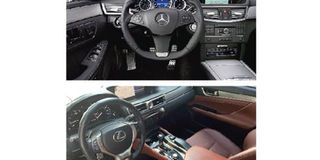Head to head: 2014 Lexus GS350 vs Mercedes E350

The battle of midsize executive sports sedans continues and has not spared Lexus GS and Mercedes E class. Traditionally, German luxury sedan manufacturers such as Mercedes, BMW and Audi have dominated this car segment with superior designs, excellent performance, cabin quality and innovative comfort features, safety and passive driver assist technology.
Increasingly, Lexus has used electronics, sporty appeal and good engines to challenge the status quo and dominance of Mercedes and BMW in this segment. Let us see if the popular 2014 used Lexus GS350 can tip the scales with the updated W212 2014 Mercedes E350.
Styling and design
The 2014 Lexus GS350 and the midlife facelifted Mercedes W212 E350, both fourth generation, are a refinement of the most popular midsize sedans in their respective stables. The Lexus GS350 styling cues depict passion and aggression. The GS350 is re-skinned and looks poised and bolder. Its hyper large spindle shaped glittering front grille sits on an equally aggressive angular bumper and sharp bright headlights. This sculpting takes a bit of getting used to.
The Mercedes E350 front end styling is calmer and more serene with no glitz and glamour, a typical spiritual centre and best seller of Mercedes Benz. The refreshed E350‘s front head lights are gracefully contoured and sit well on the bumper intake air dams. The bolder illuminated Mercedes Star looks good on the stylish new look grille. The Lexus GS’s aggressive theme persists with more creases, lines and subtly bulging elegant body flowing to a calmer stylish rear end. Mercedes E350’s subtler lines and softer curves replace the austere looks and awkward creases of the earlier W212 Eclass
Performance and ride handling
Lexus GS350’s 3.5 litre V6 engine is more powerful (311HP) and slightly more fuel efficient (13.2 KM/Litre) than the Mercedes E350 3.5 litre V6 engine (302HP) at (12.8 KM/Litre). GS350 appeals to the soul and emotion of the young at heart with its race engine rumble and quicker response when the accelerator pedal hits the floor. The GS350 impressive performance is augmented by its eight-speed automatic gearbox, which has three driving modes ECO, SPORT and SPORT S+. These vary the transmission shift timing and throttle set up to give the GS350 a performance edge over the Mercedes.
The Mercedes E350 smaller engine power and seven-speed gearbox allow it to pass slower moving traffic without straining the V6 engine. The E350 performance satisfies the corporate executive who has no reason to chase the car ahead of him. The GS350’s sportier multi-link suspension and responsive variable gear ratio steering give it firm and confident handling qualities during aggressive driving on the winding highways.
The E350’s more tamed suspension matrix and electric steering ensure a smooth, solid and superb ride handling experience suitable for medium speed luxury driving. In tight corners, the E350 feels unsettled when you drive aggressively.
Comfort

Production. Made since 1953, the E-Class falls midrange in the Mercedes line-up, and has been marketed worldwide across five generations. PHOTO/NET
The Mercedes E350 interior offers classy interior finishes, elegant furnishing and a quiet cabin with supportive spacious seating. The E350 infotainment display interface is user friendly but a bit outdated. Nonetheless, all control knobs, stalks and switches are easy to reach and use. Lexus S350 padded leather surfaces and upholstery relax the occupants in a more spacious seating space and head room appointed with walnut wood trim.
This is in stark contrast with Mercedes E350’s chrome and vinyl interior finishes. S350’s bigger 12” impressive infotainment display is controlled remotely by a futuristic touch mouse controller located on the lower centre console.
Safety
The E350 and S350 have high safety ratings with equally impressive and useful convenience and safety enhancing technology such as push start button, park assist, heads up display, lane change assist, collision avoidance systems, driver monitoring (vibrates the steering when you sleep or brakes the car autonomously) and airbags all round.
Lexus goes a notch further with heads up display in colour and blind spot monitor.

The choice between these two vehicles will depend entirely on what the motorist prefers. PHOTO/net




